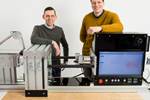TPRC develops continuous optical reflection characterization setup for AFP
As part of the NXTGEN Hightech program, developer Joran Geschiere achieved a setup that can characterize entire spool lengths of UD tape meant for the AFP process.
A continuous optical reflection characterization (CORC) setup for unidirectional (UD) tapes has been developed by the ThermoPlastic composites Research Center (TPRC, Enschede, Neherlands) as part of the composites manufacturing project in the NXTGEN Hightech program.
The goal was to develop a setup that can characterize entire spool lengths of UD tape meant for the automatic fiber placement (AFP) process. According to the TPRC, material properties of interest are far from conventional. The setup measures the way in which the tape surface scatters laser light in so-called “reflection-patterns.” It can do so while varying the angle of the laser with respect to the surface and with respect to the fiber orientation of the tape. The setup can operate autonomously while generating large quantities of data, replacing labor-intensive manual characterization experiments.
The laser reflection patterns can be used to fit bi-directional reflection distribution (BRDF) functions specific to any (batch of) material. These fitted functions can serve as an input for optical simulations of the AFP process. The TPRC says this can enhance the accuracy predicted nip-point temperatures obtained with AFP process simulations.
Three reflection patterns obtained with the CORC setup using unidirectional C/LM-PAEK (TC1225) tape from Toray Advanced Composites. Laser elevation angle of 20° with respect to the surface. Azimuthal angle of laser with respect to the fiber orientation from left to right: 90°, 45° and 0°.

Schematic overview of the CORC setup.
Besides simulation accuracy, the data can also be used by material manufacturers during the development of new materials particularly suited for the AFP process. Different optical behavior between batches can quickly be distinguished without the need for extensive AFP test campaigns.
Next to the laser scattering measurement, a commercially available laser line scanner is installed in the CORC setup. With this, the TPRC can map the topography of the tape surface up to microscale accuracy to provide additional data about the tape material and to study the underlaying mechanisms causing the differences in optical behavior.
The setup can also wind the tape material tightly on a new spool after testing, enabling use of the spool in the AFP process after acquiring data.
Related Content
-
Plant tour: Spirit AeroSystems, Belfast, Northern Ireland, U.K.
Purpose-built facility employs resin transfer infusion (RTI) and assembly technology to manufacture today’s composite A220 wings, and prepares for future new programs and production ramp-ups.
-
Industrializing additive manufacturing in the defense/aerospace sector
GA-ASI demonstrates a path forward for the use of additive technologies for composite tooling, flight-qualified parts.
-
3D-printed CFRP tools for serial production of composite landing flaps
GKN Aerospace Munich and CEAD develop printed tooling with short and continuous fiber that reduces cost and increases sustainability for composites production.


















